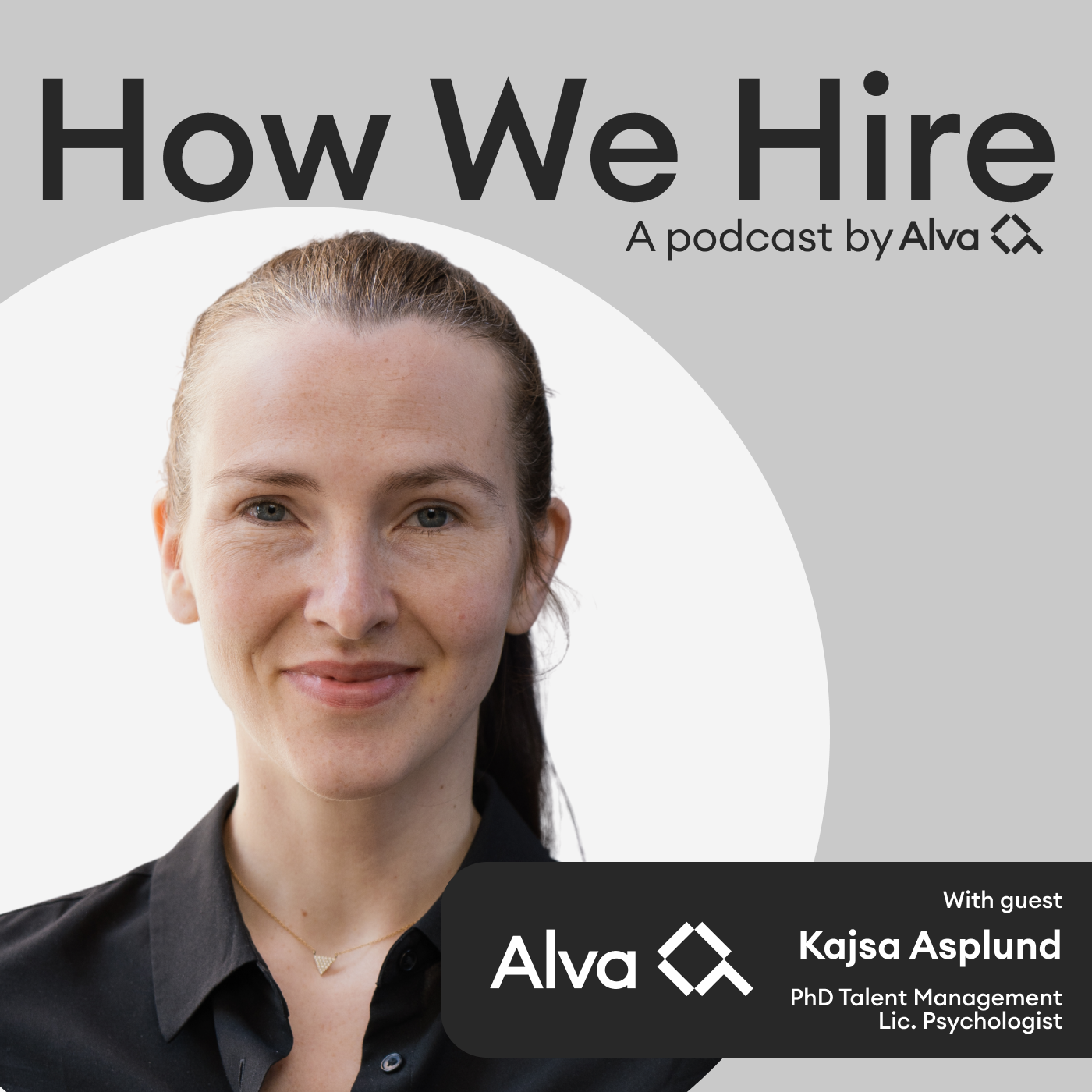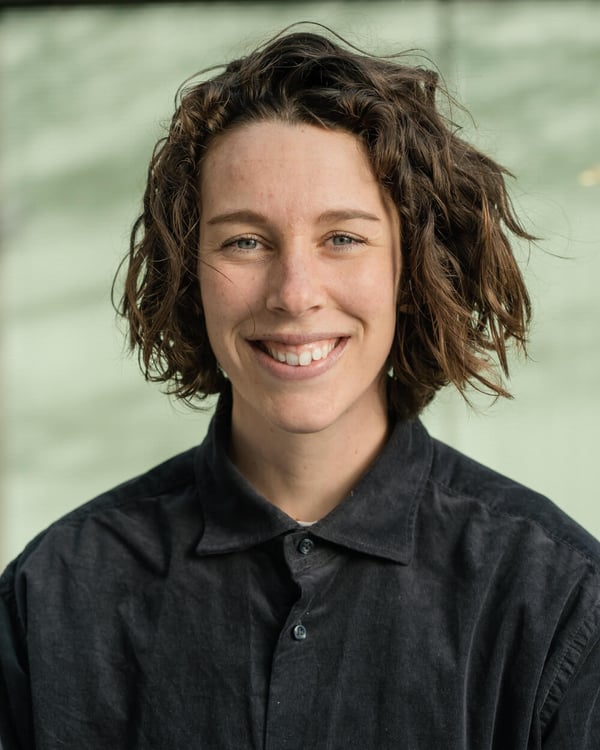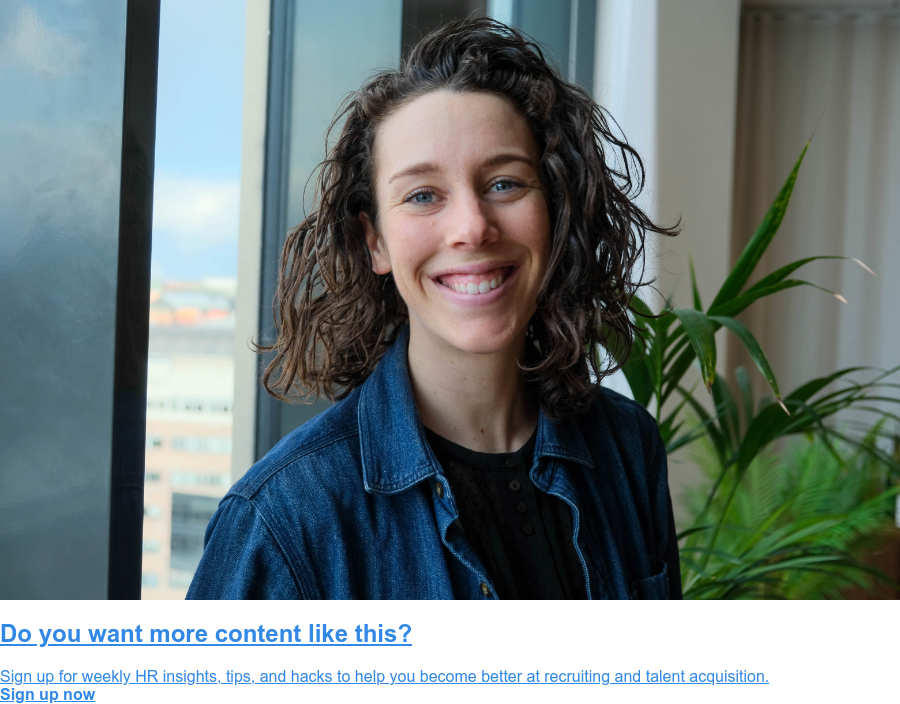How We Hire Podcast: Episode 8 Transcript
Speaker 1 (00:06):
Welcome to How We Hire, a podcast by Alva Labs.
Tove Hernlund (00:09): With me, Tove Hernlund.
Linnea Bywall (00:10): And me, Linnea Bywall.
Speaker 1 (00:12):
This show is for all of you who hire or just find recruitment interesting. Every episode we will speak to thought leaders from across the globe to learn from their experiences and best practice within hiring, building teams and growing organizations.
Tove Hernlund (00:31):
Welcome to another episode of How We Hire, the podcast where we discuss all things hiring with some of the top HR and talent acquisition minds. I'm your host, Tove, events and community manager at Alva Labs.
Linnea Bywall (00:44):
And I'm Linnea. I'm the head of people here at Alva Labs.
Tove Hernlund (00:47):
And our guest this episode is Kaisa Asplund. Kaisa is a psychologist and has a PhD from Stockholm School of Economics where she focused on talent management. She lectures about talent management and have written a popular book based on her own research called Talent for People. On top of all of that, she's also people science lead here at Alva Labs and one of the brains behind our platform. Welcome to How We Hire, Kaisa.
Kaisa Asplund (01:12):
Thank you, Tove. It's lovely to be here.
Tove Hernlund (01:15):
So happy to have you here today, and today we will be focusing on your area of expertise, talent management, but before we get into that, I'm assuming that we all might have a little bit of a different view on what talent and talent management is. So would you mind giving us a little bit of a definition?
Kaisa Asplund (01:33):
Yes, sure. And I think you're definitely onto to something there, Tove, that talent is one of those terms that's really lacking solid definition. It's floating around in the HR and people community and people are filling it with very much their own meaning, which I think is one of the reasons why the term is so popular as well, because you sort of put your own meaning into it. But if we try to look at it from a scientific standpoint where you actually have to try to define your terms, I think the closest you can come to how talent is used out in organizations is people who are especially good at something, right?
Kaisa Asplund (02:14):
People that have an unusual level of competence or future potential within a certain field. And then there are loads of different trade offs that you have to make with this term. How much is it about future potential versus past track record? How much is this something innate that you sort of carry with you versus something that you actually train during your career and so on. So there are lots of different dimensions on which organizations differ when it comes to how they define talent, but at the core is this idea of being especially competent in some area, I think.
Linnea Bywall (02:50):
If we then move over to talent management, how will we define that term?
Kaisa Asplund (02:54):
Again, there's no solid definition, but I would say that there are two main versions of it out there. One is the more exclusive kind where talent management are those practices that center on attracting, identifying, developing, retaining, those A players, quotation marks. The ones that are seen as especially important for the long term wellbeing of the organization, so the stars if you will.
Kaisa Asplund (03:20):
Whereas in many organizations, the term is actually used a lot more broadly where it's more about attracting, identifying, developing, retaining all the employees that the organization needs for its long term success. And then it's more about developing the potential of all the people that you have in your organization. So we can use it more broadly or a bit more narrowly I would say.
Linnea Bywall (03:43):
And I guess we will go into what's the best way to use the term, but before that, I mean I'm really interested in how on earth did you end up in talent management? Why was that your top pick for doing research within?
Kaisa Asplund (03:59):
Yeah, that's a great question. I guess it was the usual serendipity to some extent. I have always been passionately interested in the psychology of work and I was looking for the best way to practice that after graduating from my master's in Uppsala, and then I saw that Stockholm School of Economics was looking for a doctoral student within this area.
Kaisa Asplund (04:22):
And the more I started reading about it, the more I realized that this is such a yummy topic for a psychologist, right? Because it has all of those ingredients, like picking certain people from the crowd and saying, "You are special." What happens to those people? What happens to the other bunch? Will those people that are selected actually want to stay longer or will they realize their value and move on? Will they rest on their laurels or will they rise to the occasion? There are loads of different super interesting psychological questions in that field. And I still feel that this is a really yummy topic for a psychologist.
Tove Hernlund (04:58):Kaisa, we have to also take the opportunity to ask you what was the... I guess you might not want to reveal this for people who might want to read your book, but what was the most surprising insight that you found during your research?
Kaisa Asplund (05:12):
I think one thing that... I'm not sure how surprising it is really, but it was at least not what research expected, was that those that are selected as talents, those that are included in talent programs and so on, actually show no sign of what we call the crown prince syndrome, that you sort of lean back and think, "Oh, now I don't have to make an effort anymore. Now it's all set." There's actually very, very little proof of that in my research or in any other research for that matter. It seems like those people that are selected for those types of initiatives, they get selected, because they have that almost trait engagement, if you will. So no matter where you put them, they are going to work hard, make an effort, try to be better, that's part of their being I guess. So that was an interesting finding, but of course that's not to say that you can't go wrong with these initiatives, but at least there's no sign of the Crown Prince syndrome.
Linnea Bywall (06:08):
And why do you think we have the belief that that should be a thing?
Kaisa Asplund (06:11):
I'm not sure. I think one part of it is this general tendency to underestimate traits. We see that all the time in recruitment as well, that people sometimes seem to... I mean, I'm not saying that context is not important. Of course the work environment that we're in, it's actually absolutely crucial, but for some reason people tend to also underestimate the importance of who you are as a person, and that certain traits tend to go with you no matter where you are. No matter if you're on your first summer job or in a senior management position, you take certain traits with you, and I think that's sometimes underestimated in the field.
Linnea Bywall (06:52):
Talent management is obviously something that I work with a lot and I have a luxury to pick your brain at a daily basis Kaisa, but for those who can't do that every day, if you start from scratch. We want to start some sort of talent initiative, but first we need to identify the talents. How would you go about that?
Kaisa Asplund (07:10):
Yes, that's a great question. And I think at the core are the same practices that we recommend for recruitment overall. So we know from decades of research which methods actually predict performance and which don't. And especially on a statistical level, when you have a larger number of candidates, then you can pick. So then you have the usual suspect such as evidence based tests or personality and certain cognitive abilities. You might want to work with some kind of background data, but keep that to a minimum to make sure that you don't exclude people unnecessarily.
Kaisa Asplund (07:45):
And then you probably want to work with some kind of structured process containing perhaps
interviews and cases and things like that. So it's the bread and butter of evidence based recruitment, but of course one thing that comes before that, and that always needs to be stressed, is have you done a proper analysis of the demands that you're putting on these people? Have you done your homework on thinking about what is it that we want these people to do? What are we naming them talents for? Are we talking about leadership talent? Are we trying to provide people for the succession planning? Are we looking for great team players who can play vital roles in our more analytic teams? Are we looking for collaborative talent? That kind of analysis of course precedes the whole process, the whole selection step.
Linnea Bywall (08:34):
And I'm guessing then that if you really want to do the groundwork, you need to know what actually works well in the organization? So we have a definition of talent. We know what we want to build for, and that could be culture, it could be values, but it can also be hard performance. And then actually, because I'm guessing, and correct me if I'm wrong, that a lot of organizations skip that step where you have a vague idea what talent is and then skip straight to selecting those people and maybe you then don't get the definition right.
Kaisa Asplund (09:09):
Certainly, certainly. And I mean we know, who work in the field, that danger looms where you have these vague definitions, right? Because as soon as you have that, there's a risk that the similarity bias creeps in and you start looking for success where you have found it before, if you will. So there's actually been a number of really interesting studies recently where researchers have tried to really drill down on, "When you say talent, HR, or when you say talent, hiring managers, what do you actually mean?"
Kaisa Asplund (09:42):
And the interesting thing that comes up is that when you ask them the question first, they usually bring up things that have to do with long term future potential. And they talk about how people can be talents, although they're not performing at the moment, because maybe they don't have the right conditions in their work environment, maybe they don't have the right training and so on. But once you drill down one level further, and ask them how they actually define talent in their day to day operations, then the focus is very much on past performance and some track record that you have in the organization, and it's very much also on leadership talent, which is usually doesn't seem to be a conscious choice. It's more like there's an underlying assumption that talent equals leadership talent. So when you use the term half vaguely, you tend to end up focusing on past performance and leadership talent, which is kind of interesting.
Linnea Bywall (10:39):
I mean, because I think this is a discussion that we've had internally here at Alva. We don't want to only optimize for succession planning around leadership, but really actually put the big box on developing individual contributors and really creating a career path around that. I'm not sure we have succeeded yet, but what would be your solution for optimizing for that Kaisa?
Kaisa Asplund (11:05):
There are several things you can do obviously, and I think you're on to the first part here, Linnea, which is actually defining a career ladder of some sort for that kind of talent. That has less to do with the need for the actual career ladder and more actually about [inaudible 00:11:22], because that's something I've seen time and time again. If you want to raise your salary and get the better benefits internally without leaving the organization, then you need to go to the managerial track.
Kaisa Asplund (11:33):
And even though people might not say that explicitly that that's the reason, that's oftentimes the case. I think the first part is to actually figure out how to pay people more if they advance on an individual contributer track and how can you let them grow and take on a bigger responsibility. Another part that I think is really interesting is to think of which people get a say in the talent identification process internally, where you can actually see that the more emphasis that you put on senior managers to make this choice, the more they're going to focus on leadership talent. Whereas if you ask the peers, for instance, so the people that work closely with this person in the day to day, so the teammates and so on, they tend to focus a lot more on analytical talent as well. They seem to be more focused on those broad talent characteristics that have less to do with leadership and more with grappling with complex information and also the collaborative skills. So I think including the peers in that process also holds a really important promise.
Linnea Bywall (12:37):
And that's a really good hack just to include peers both in maybe the definition, but then also for the
selection.
Tove Hernlund (12:44):
One thing that I'm thinking about just related to this selection, how do you make sure that people don't feel unfairly selected or not selected and I don't know, jealousy maybe?
Kaisa Asplund (12:58):
Yeah, yeah, I mean a great question as well. I think there are two factors that research has found to be super important here, and those are fairness and transparency. And of course fairness precedes transparency, because if you're not fair in your selection then it won't really help to be transparent. And of course, I mean there are different schools here, but I would be more with the team who would argue that there is no such thing as perfect justice or perfect fairness when it comes to these selections.
Kaisa Asplund (13:30):
We will end up making certain trade offs and somewhere along the process there is going to be some kind of holistic judgment where it's very hard to explicate exactly what it was that made you choose person A over person B, but at least we can try to come as far as we can in using objective criteria that we define beforehand, where we make this sort of gap analysis for the candidates. Where we try to be as explicit as possible about what are we basing this selection on and where were the gaps that contributed to you not making the cut, for instance. And then being as transparent as we possibly can around why the selection went the way that it went.
Kaisa Asplund (14:15):
When it comes to the final selection where usually a more holistic judgment comes in, my experience is that it's usually better to be transparent about that as well and say that, "We used these very analytical methods to begin with, but in the final choice we had to make a holistic judgment and this was where we landed, right or wrong." Usually people can actually accept that if they see that you've made the effort to be as fair and transparent as possible.
Linnea Bywall (14:40): I like that a lot.
Tove Hernlund (14:41):
Me too, but I have a question and sort of the real world question, because in theory, I think everyone can agree that this is how you should work, but I have a hunch that in a lot of organizations, going back to how you select talent, it's more or less the manager saying, here are my three talents, use those for the talent program, and then there's absolutely no selection method. I think I have two questions on this. First of all, what's your view of how many organizations actually work the structured with their talent selection and two, what can you do to take the first steps if you are in the position where the managers just pick their top talents with no actual process behind it?
Kaisa Asplund (15:26):
The answer to the first question would unfortunately be, still very few. There are still very few organizations that really employ this structured, thought through method, I think. However, they are growing in numbers, because more and more people realize the research behind it and the benefits that you can get from a more structured process, not least just in terms of time save from HR actually being able to provide a response to why the selection went the way that it went, and not having to handle all these angry voices, perhaps rightly telling them that this was unfair.
Kaisa Asplund (16:03):
As an organization when you start this journey, I think the first thing that you have to point out to get management's attention is really the business value of doing this right. Both in terms of not losing those high performers that were about to make the cut but didn't, and also actually choosing those people that have the long term potential to grow within the organization and the business value that you can get from that. I think that's the most important part. Another aspect of it that I think is coming more and more to management's attention is also the diversity aspect of it. That we can't continue going around having only white males making the cut for a talent initiatives. So something needs to change.
Linnea Bywall (16:51):
So if we just sum up where we are now, we have identified what talent is for us. We have hopefully created incentives and compliment bend that actually helps us be true to that definition. We have had a structured process of identifying the talents, which I guess sounds a lot like you should pretty much mimic your hiring process. So, if you are in a wider organization, I guess the leadership and development team should really tag team with the TA team on this. But seeing that we have identified the talents in a fair, transparent way, now what? What should the actual program, models, happenings be?
Kaisa Asplund (17:32):
Yes. That's another really tricky question, I think. And if you look at research, there's actually evidence of these initiatives going both ways. If you do it right, you can end up with higher engagement, talents that actually perform better, that are more motivated and so on. If you do it the wrong way, you might end up with talents just leaving the organization or getting really disengaged. So planning the program outline carefully is time well spent, I would say. The first part actually has to do with clarifying expectations, because there is one research finding that really stands out as the most solid one of all when it comes to the effects of talent appointments, and that is that those that are selected as talents get higher expectations on the organization. So they expect more in terms of career coaching, clear career paths, a plan for your future development.
Kaisa Asplund (18:27):
I remember when I was talking to one of the interviewees that I had for the book, who had been selected for one of these prestigious programs, and he said it very succinctly that, "If you selected me as a talent, then I guess there's a plan. Then you got to have a plan for... What do you want to use me for? What do you want me to do if I'm a talent?" And then I realized that there was no plan and that's where his engagement went down. I think the first part is about clarifying what can you expect out of this program and what do we expect from you?
Kaisa Asplund (18:58):
And usually I think it's a good idea to try to clarify that you are in the driver's seat of your own development. It's you who have to set the direction and put in the work. And we are here to clear the path for you to make sure to help you with any obstacles along the way, sound advice on what's possible and what's not, navigate internal politics or whatever. So clarifying the expectations I think is the first step that you need to get through before you put in the actual modules and so on.
Tove Hernlund (19:29):
And I guess that ties back to having the definition and knowing what it actually is that I want to achieve
with this?
Kaisa Asplund (19:37):
Yes, yes, to be sure, because then it gets a lot easier to actually point out what is it that we want to happen here in the organization? What strategic change do we expect you as talents to help us drive? And that's usually actually really motivating as well to get to hear that you are included in some kind of grander scheme of where we're going with this organization and we want you, our talents, to be the ambassadors of that change and that journey.
Kaisa Asplund (20:05):
So that's usually a very good thing to have there. Then when it comes to the actual content of the program, I think there are so many different ways that you can go about this, but one thing that research has also found, is that it's usually really beneficial for talents to have this forum where they can train their identity as more senior members of the organization, if you will, because transitioning in an organization and taking on a bigger responsibility, is not only about actual tasks, it's also about identity and how you see yourself and perhaps a certain way of communicating that you need to adopt, a certain identity change that's going about. It seems like having this safe space with other people that are also grappling with that, sometimes pretty turbulent, journey can be a very good way to make that development happen.
Kaisa Asplund (20:58): But then of course you need to create that space of psychological safety and openness and where
people feel good talking about these things and not just making this a club for admiration.
Tove Hernlund (21:09):
I'm really glad that you lit this because it sounds like it's about expectation management and having a plan, but also putting the talent in the driver seat for that plan, but then also creating the opportunities to grow into the coming roles. And I just... As an example from Alva, one of the leadership programs we run, I do trainings and there's coaching, but then the most appreciated part is actually where, we call them leader ladder buddies, where you actually get someone from another part of the organization where you just meet, there's no agenda. The only things is discuss relevant topics for you right now. And that's often the one forum that gives you the most, because you get to discuss really similar topics but from very different angles, and that's super helpful.
Kaisa Asplund (21:56):
Yeah, I mean definitely and having that role model, both in terms of skills and a way of being, but also having someone model behaviors such as sharing problems, sharing worries and anxieties and things that don't feel so good perhaps, because of course there's going to be a certain amount of anxiety involved when you are selected as a talent or high potential or future leader or what have you, because there are expectations and of course you feel the weight of those expectations.
Kaisa Asplund (22:31):
Also, for many people, it's about transitioning from a pretty operational focus where it's a lot about solving day to day issues and getting work done, towards a more nebulous type of work where there are fewer right and wrong answers, there are fewer clear signals that you're done with a certain task and it's more about the wide perspectives and long-term initiatives and so on. That can be really scary for people who are used to just delivering on the day to day. So that's a transition that you need to support them with.
Tove Hernlund (23:04):
And I think as well as it's a new thing and a new way of working, but it's also, as you say, you remove the positive and reinforcement that you naturally get. So if you're used to doing this day to day, very operational, you will get reinforced when you're done with something. And then with this more long term strategic, there's no right or wrong, it's much more vague and the positive reinforcement is completely eliminated, which can be super tough. And also something that will draw you back to that operational focus. Okay, so we have select our talent. We have set direct expectations, we have created this forum. What else?
Kaisa Asplund (23:45):
What else? So of course there is also going to be a certain amount of pure training involved, so some kind of skills training or things like that, right? In that area, again, I would like to emphasize that it's easy to fall in the trap of only including leadership trainings where, I mean, if we look at the future of work, we know that there are so many other skills that people will need, regardless of whether they're in leadership role or not, which have to do with handling ambiguity, managing a very diverse set of people or handling a much more diverse workplace, dealing with long term threats of different kinds. So I think there's so much more you can do than just your old school leadership training, if you will. So there I would like to encourage companies to think a little bit outside the box.
Linnea Bywall (24:36):
It's game time. Kaisa, you do your pick of the three most important topics, and I'll do my three and let's see if it's a matching list. What three areas would you include in the program?
Kaisa Asplund (24:49):
Ooh. All right. So we write it down?
Linnea Bywall (24:53):
I guess so. Otherwise it's cheating, right?
Kaisa Asplund (24:55):
Yes, yes. All right. I have my three. Do you want to go first Linnea?
Linnea Bywall (25:00):
Should we do, I do one, you do one and then let's see?
Kaisa Asplund (25:03): Okay.
Linnea Bywall (25:04):
Okay, my first one will be purpose, meaning finding your own purpose and let that be your compass in everything you do, because I think that's the key to being more of a visionary person, connecting with the strategy and the overall company purpose. So I would say connecting to your purpose and letting that guide you. That's my first one.
Kaisa Asplund (25:29):
Very nice. I actually had something very similar as my first point, which is just self leadership, which I
think goes very much hand in hand with that, right?
Linnea Bywall (25:37): Yeah.
Kaisa Asplund (25:37):
Because if you are going to lead yourself, you need to know you are in your compass and what will you
never compromise on.
Tove Hernlund (25:45):
Yeah. Yeah. Okay. Very good. Linnea has number two, goal setting.
Linnea Bywall (25:51):
Simply because I think regardless if you work as an individual contributor or a leader or just a strategic
person, you will always set goals. It might be for yourself, it might be for a team, it might be for the
entire company, but you can never underestimate the power of really clearly defined goals. So I would
say master goal setting and you come a long way.
Kaisa Asplund (26:13):
That's a really, really important point as well, and sort of jealous that I didn't have that one on my list. I mean, because if you think about it, there's so much research support saying that no matter the context, when you compare, just telling people, "Go ahead and do your best" and actually setting an ambitious goal, people will perform better with that ambitious goal, given that they also have, of course, the right conditions in the work environment and the feedback and so on. But still.
Tove Hernlund (26:44):
So Kaisa, what was your number two on this list?
Kaisa Asplund (26:48):
So my number two was actually collaborative problem solving.
Tove Hernlund (26:51): Ooh.
Kaisa Asplund (26:52):
Which I think is one scale where we have a long path to go. I think we are coming from an era where what we call, at least in Sweden, we call it social competence, has become really important. So we have realized that it's really important to be a good team member, to be able to work together with other people in a seamless way and a smooth way, but we haven't come as far when it comes to actually being codependent in how we solve problems. It's a bit like moving from baseball to soccer if you will. It's not just about shooting the ball to another person and they toss it in another direction. It's actually about that very fine tuned collaboration that you need to develop in order to solve the really big complex problems that today's organizations are dealing with. So I think that that's the magic that can happen when a team really engages in collaborative problem solving. That's money, right? Money in the pocket for the company. So I think that's one... That one's going to be really important in the future.
Linnea Bywall (27:55):
Very good one. Also jealous I didn't write that one.
Tove Hernlund (27:58):
Okay. Linnea has number three.
Linnea Bywall (27:59):
This is a personal favorite of mine, but personal impact. I've done a lot of trainings of this in the past, both here at Alva, but also at other companies where you pretty much... Technically it's like actor training, but where you actually work on how am I being perceived, how can I use tone of voice, body language, all those tricks to actually get a message across, because same thing here. It doesn't matter what type of position you have, you will need to impact people, you will need to convince people, and the only way to do that in a successful way is to understand how am I coming across? Is that how I want to come across? And if not, how can I change it? So personal impact is a big one for me.
Kaisa Asplund (28:43):
That's a really important one as well. And I think that that one is also really interesting from a diversity and inclusion standpoint, because there's really interesting research showing that one reason why, for instance, women and people from minority groups don't get selected as talents, has to do with communication style, which is something that you learn very early on in life and where, for instance, we know that white males are taught to speak up, to toot their own horn, taking credit for their accomplishments, sounding very confident and very sure about what they say, whereas women from a tender age are usually taught a more humble way of speaking, which seems to come across as less confident, less leader like, et cetera. So I think this is something that companies need to address more.
Tove Hernlund (29:39):
Yeah, there's a very, very sad, I guess joke, but still. What's the difference between assertiveness and aggressiveness, and answer is your gender. Because if you ask, a woman will take on those male attributes, which are just as common in women, we're just taught to not show them as much, you will be interpreted much differently compared to your male counterparts. So there's something around that that's really, really interesting. So yeah. Okay, what's your number three Kaisa?
Kaisa Asplund (30:08):
Okay, so my number three was actually a pretty generic one, but still, coaching skills.
Tove Hernlund (30:14): Good one.
Kaisa Asplund (30:14):
Which is... Yeah, I think this one is also... You see it all around. This is going to be so vital for not only the leaders of tomorrow, but actually the team members of tomorrow as well. Just think of the common exercise of writing performance reviews and actually providing feedback for your colleagues, how hard it is to write something that's actually actionable, that's thought through, that's changeable. There is something around helping your coworkers grow that has to do with coaching skills, I think, that we could utilize much more.
Linnea Bywall (30:52):
Very good. Okay, so now you have a list of three plus three great stuff that you should include in your talent management program.
Tove Hernlund (30:59):
It's a great start for anyone who's looking to improve. There's the manual, right?
Linnea Bywall (31:04):
And if you don't trust me, trust Kaisa. Pick from her list. I think we've gone through how to identify, how to set the expectations, how to design the program. Wrapping things up, ending a program, is that a thing?
Kaisa Asplund (31:22): It's a thing. It's a big thing. I'm glad you asked Linnea, because actually we saw very clearly in some of our studies that the transition point where you exit a talent program is actually a really critical turning point where some people choose to lead the organization and it probably has to do with multiple factors, but the most important one is probably that you go from being this very celebrated, attended to, cuddled program participant back to being your, quote, regular employee.
Kaisa Asplund (31:55):
And that can be a pretty scary transition, because all of a sudden it's up to you again. I think one mistake that many organizations do is that that transition becomes too brutal. There's too much of a contrast between being in the program and being out of the program. I actually usually advise companies to invest some part of their talent management budget in the transition out of the program to make sure that people still have a bit of that career coaching, the extra support, so that they hit the road running once they exit the program as well.
Kaisa Asplund (32:27):
So I think that's really important. The other part is about the signaling value that you have [inaudible 00:32:33] during the program, that now you have something to put on your CV, which can signal high competence level and high potential to other employers. So maybe you actually use that to look for another job, which is why I also think it's really important to pick up where people's heads are at towards the end of the program and make sure that you have an attractive next step for them so that they're not too tempted to just take this merit elsewhere.
Linnea Bywall (33:02):
That's a really good point. What would be easy hacks to make sure that... What would you spend the budget that you've saved on?
Kaisa Asplund (33:09):
I think first and foremost, career coaching. So making sure that you have a more senior buddy or an HR person or perhaps both to make sure that these people are guided towards the next step in their career and that they can also see a future pathway from there on. I think that's the single most important part. Yeah, I think if you do that then you're well along the way.
Tove Hernlund (33:33):
What is the value versus maybe negative effects of having some sort of continuous forum? Like you said, it was important during the program to have some sort of forum, but I can imagine if you continue with that forum, the positives might be that you have a strong network and you can connect with the other talents and continue that way, but it might also make the rest of the employees feel more excluded because then there's a continuous forum that they're not a part of. What are the positives and negatives of continuing on with that type of work?
Kaisa Asplund (34:05):
Very good question. I would say from my experience, the most common version is that you just let these people continue spontaneously with that, with those sort of connections that they built. That's usually enough. I mean, people are usually motivated to keep on those connections on their own there. So the organization doesn't usually need to keep that up as a formal thing. I mean, based on what you just said, Tove, that might actually be a good thing that you don't continue to highlight that this is some kind of special secluded group that you cannot be a part of, because the talents will leverage those connections, that network anyways.
Linnea Bywall (34:46):
Okay, I think we've gone through the majority. So this is now your how to create good talent management program podcast. Have we missed anything, Kaisa? Some obvious knowhow do's and don't that you want to add?
Kaisa Asplund (35:02):
I think we have covered most of it. I think an overarching question of course, that you need to ask yourself is, is a program the best format for your organization to do this thing, because it's going to take a lot of resources and appointing people as talents is no free lunch. It's not like you can just put this stamp on certain people and they will be more engaged all of a sudden. Rather, it will raise their expectations. They will expect more of coaching and the faster career development and so on. So you need to be able to back that promise up. And if you know that you don't really have those resources currently, then it's usually better to invest more in let's say, managerial support, making sure that the managers closest to the employees are well equipped with feedback skills and coaching skills and goal setting skills and that kind of stuff to make sure that people are engaged in the day to day.
Kaisa Asplund (35:53):
And also, I would say if there are very few career paths within the organization, if the organization is fundamentally very flat, then you might also want to consider is a program really best way to go about this? Or are there other ways?
Tove Hernlund (36:09):
Very interesting, Kaisa. Thank you so much for being here and sharing your expertise today, and thank you Linnea for sharing as well, what we do here at Alva. We hope to see you again in the next episode, coming out in two weeks. Subscribe to How We Hire on Spotify or Apple Podcasts and we'll see you again then.







